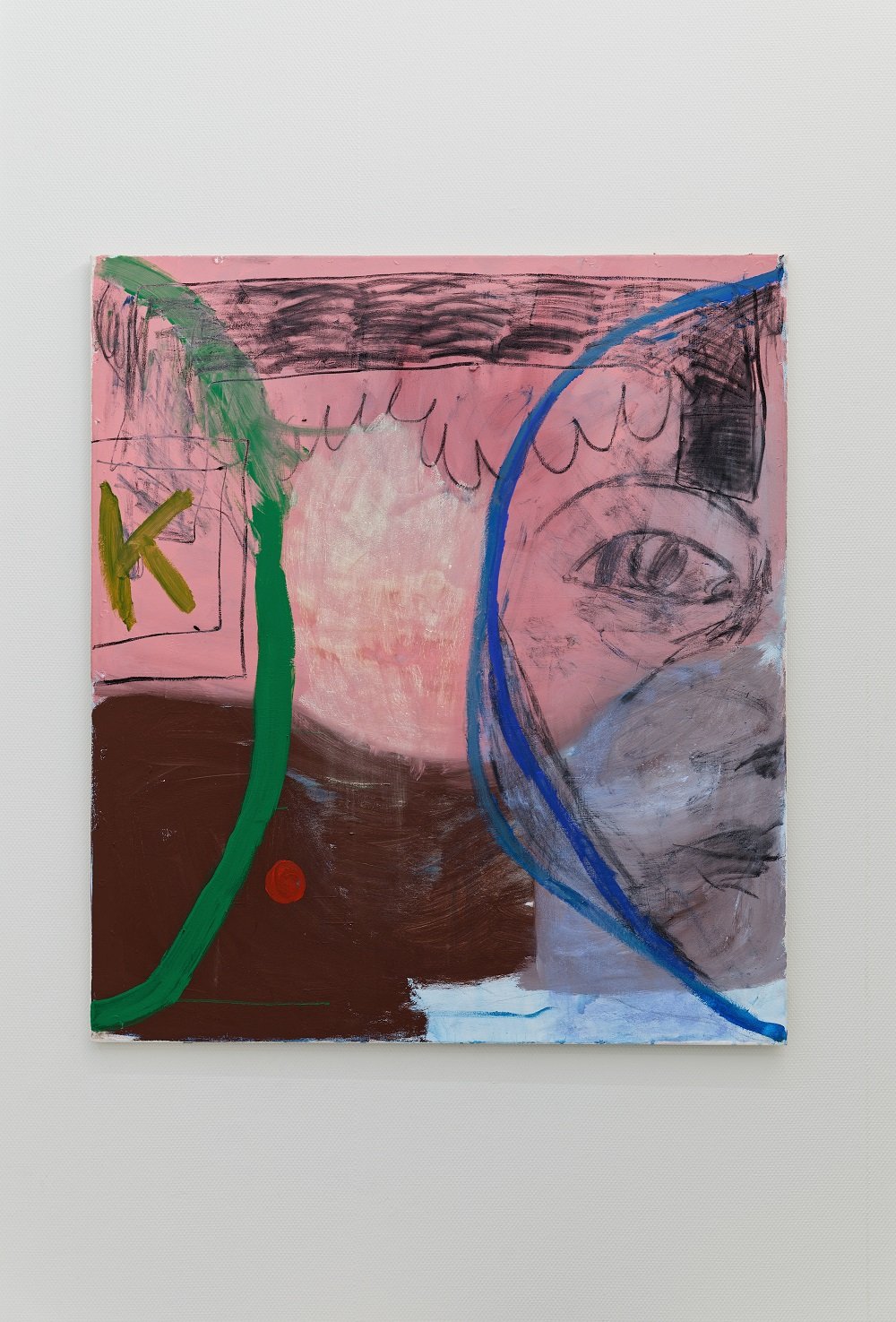
September 1 – November 17, 2024
For visual artist Klaske Bootsma (1995), who graduated in 2023 from the Frank Mohr Institute in Groningen, self-examination plays an important role in the painting process. In her search for authenticity and ultimate answers, she continuously questions her art and artistry. Her work is on show in the new solo exhibition 11:37 in AFSLAG BLV.
In this exhibition, Bootsma shows not only paintings on canvas, but also works of art made with pieces of wood fished out of the container and sawn in half. The mutual relationship between these works, both large and small, and the contrast between wood and canvas, tradition and experiment, plays an important role. Through her sometimes unorthodox choice of materials, she combats prejudices and questions what the material adds to the message of the artwork.

Bootsma also exhibits several recent drawings. Many of these drawings were created as sketches for larger works, but turned out to be the end product for the artist.
The works that Bootsma has created over the past year are a follow-up to her graduation in terms of method and style, but are a lot more personal.

Many of her paintings can be interpreted as self-portraits in which the artist repeatedly shares bits of information about herself.
Bootsma attaches importance to the fact that her work remains as transparent as possible. She is constantly looking for a personal relationship with the act of painting.
By painting a lot, experimenting with new materials and documenting the making process, Bootsma hopes to enter into an in-depth dialogue with her work.
“My paintings show a tangle of thoughts, doubts, criticism, ideas, questions and solutions without sticking to specific themes. Over the past year I have gotten a better idea of the underlying concepts and have been working on making them more apparent in my works of art. I constantly think about the value of the painting and my role as a maker. This is reflected in how I place myself in a work and which materials I choose. One day I painted '11:37' on a black board because I get up too late, the next day I used my initials as a shape on a large canvas to place myself in a signature way in a classic painting shape.”
– Klaske Bootsma (2024)

Astrid Nobel considered the Minerva Academy in Groningen and followed residency programs at Sichuan Fine Arts Institute (Chongqing), Flux Factory (New York) and Rijksakademie in Amsterdam.
INFORMATION

AFSLAG BLV, annex of Museum Belvédère in the center of Heerenveen, focused on contemporary art, offers a stage to (northern) young talented artists.
AFSLAG BLV is an initiative of Museum Belvédère in collaboration with the municipality of Heerenveen, the De Heerenveense School foundation and Museum Heerenveen, the Klaas Dijkstra Fund Foundation and the province of Fryslân.

De Heerenveense School
AFSLAG BLV
Minckelersstraat 11
8442 CE, Heerenveen
Located in the Heerenveense School, the same building where Museum Heerenveen can be found.
Tuesday to Friday 11am – 5pm
Saturday and Sunday 1pm – 5pm
closed on Mondays
Free entrance!
You can park in front of the building or in the Geerts Willigen Heerenveen parking garage
Pay times are Tues – Fri 9am – 8pm
Thurs 9am – 9pm and Sat 9am – 8pm
You can park for free on Sundays!
PAST EXHIBITIONS
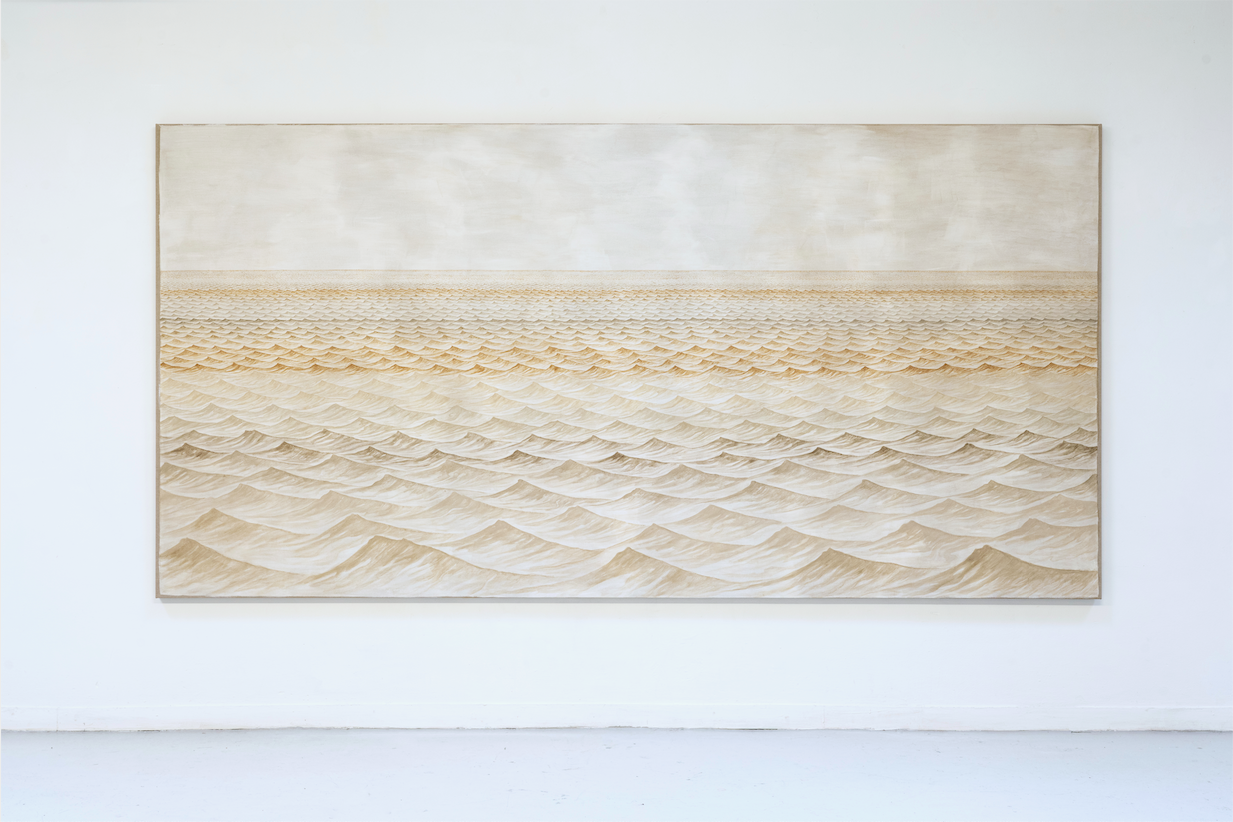
June 9 to August 18, 2024
The work of Ameland-born Astrid Nobel (1983, Hollum) consists of sculptures, installations and paintings. From June 9, she will show paintings and sculptures made from materials from the North Sea and Wadden Sea, such as sand, (fossil) bones, cockles, seawater and washed-up oil, in her solo exhibition Silence after the tern in Afslag BLV.
Although Nobel no longer lives there, her birthplace, the island of Ameland, still plays a major role in her visual work. Her involvement remains undiminished and the artist's strength is her ability to give this experience both a universal and a very personal character in her work.
Time, consciousness, nature and border areas are recurring themes in her work. Nobel is currently working on the Wadden and North Sea region and how extraction, extinction and the climate crisis affect these areas. Her personal dream diary plays an important role in the creation of her visual work.

In her work, Nobel pays attention to pollution, the consequences of climate change and bird flu as well as the power and beauty of living nature. She often uses substantive materials that are directly related to these topics in her paintings, sculptures and installations.



Klaske Bootsma studied at the Minerva Academy and the Frank Mohr Institute in Groningen. She lives and works in Groningen.
March 3 to May 19, 2024
Dieke Venema (1990, Barneveld) creates sculptures and spatial installations in an intuitive manner. In her work she is concerned with the 'how' and the mentality of the making process, in which aspects such as skin, shape and material play a major role.
If her sculptures were characters, they could be described as subdued, hesitant and modest. Venema makes her sculptures from crude materials and gives them an amorphous shape that only vaguely resembles something recognizable. Her images are therefore never definite, but fluid in meaning. Venema's source of inspiration initially provides guidance, but loses meaning during the working period.
In the solo exhibition paper, scissors in Afslag BLV, she shows, in addition to new and older work, the tufted wall works that she created in 2022 in collaboration with Het Textiellab, a knowledge and development place for innovative textile projects in Tilburg. These works are shown in combination with drawings and wall sculptures.
Venema studied at ArtEZ in Zwolle and De Ateliers in Amsterdam. She received a Young Talent work contribution from the Mondriaan Fund and the follow-up contribution: a work contribution for proven talent. Venema currently lives and works in Valkenswaard.

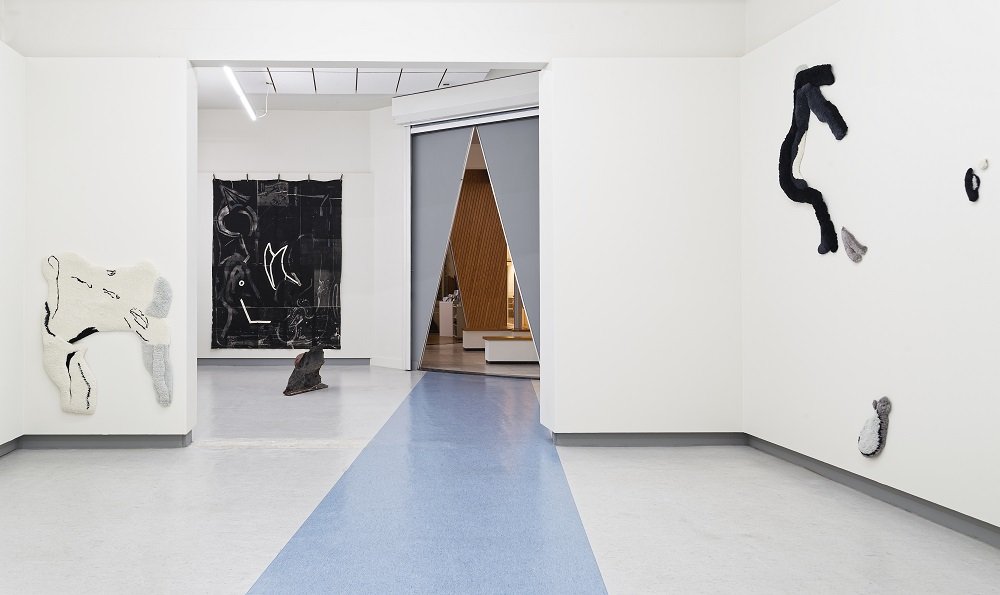

PAST EXHIBITIONS 2023
December 3, 2023 - February 18, 2024
Dinnis van Dijken (1990, Groningen) is an artist and a published writer. With his work, Van Dijken questions both the artistry and the role of painting in 2023. Questions such as: 'What is the practical use of a painting?', and 'Can a painting become an integral part of daily life or will it remain an isolated work of art?', are central.
Employing a wide variety of approaches in his work, he explores new possibilities for revitalizing painting. While intertwining underlying themes of existentialism, disability and dread, he approaches with a light-hearted manner and humour, aiming to offer a sense of reassurance and ease through his work.
“I was once described as a marriage counselor for the arts and as someone who likes to watch the world of painting burn through his artworks. I think both descriptions are correct.”

For his first solo exhibition Slap that Jello and watch it wobble Van Dijken presents several new works wherein he strives to integrate painting extensively into contemporary life, particularly in that of millennials.
Most pieces featured in the exhibition are designed to fit into his personal life and demonstrate their adaptability within and beyond an exhibition space:
While his work has significance within the exhibition as visual art, outside of it – in the home environment – it could function as a game board, tablecloth or otherwise.

Jello theory
The title of the exhibition refers to the Jello theory, popularized on platforms such as TikTok, which could help people overcome their fear of flying. This theory compares a flying airplane to a ball floating in a gelatinous space (Jello).
The pressure of the Jello keeps the ball from sinking, even when jiggled. This can be compared to what happens to airplanes during turbulence.
According to Van Dijken, this is exactly how it works with art: art is a formless entity that evolves and adapts to social changes, but will always be able to retain its core shape and function. Art crosses time, pushed and propelled by a now jiggling air-jelly mass of internet-saturated visual culture.
Dinnis van Dijken graduated from both the Konstfack University of Arts, Craft and Design in Stockholm, Sweden, and Academy Minerva in Groningen.
His work was awarded the Eva o Hugo Bergman Stipendium from the Royal Art Academy of Fine Arts (Stockholm, Sweden), the Konstfack University College Stipendium and the Lucht Stipendium from Kunstpunt Groningen.
His work is included in the art collection of the Hanzehogeschool Groningen.

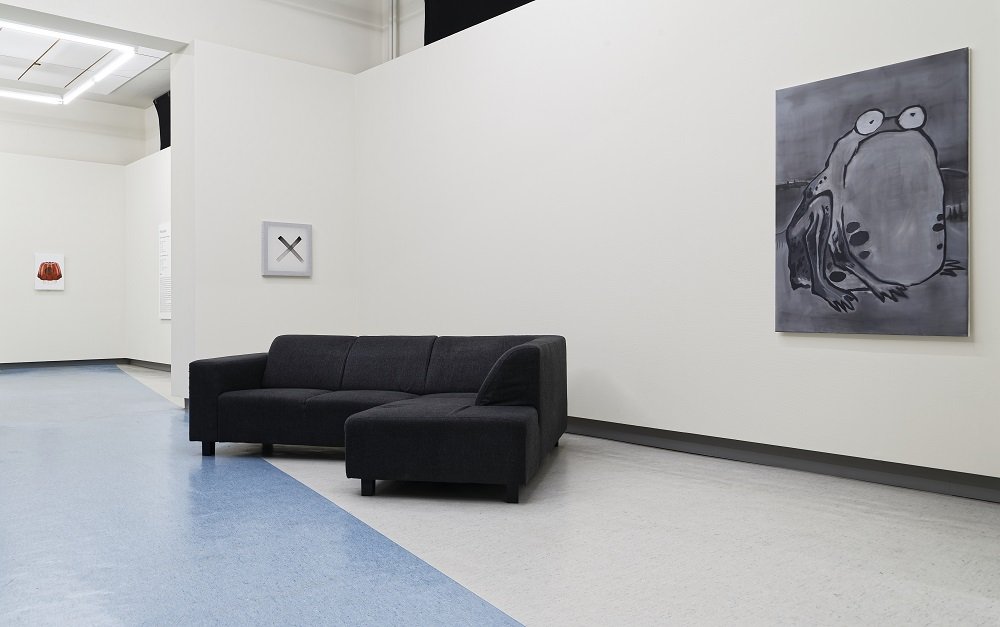
'A theory of the earth from our phones to our windowsills'
10 September to 19 November 2023
Irene de Boer (1994, Delfzijl) was born in Central Groningen, the epicenter of the Dutch gas extraction industry. This is where her interest in hidden energy fields originated and the drive to unravel the origin of material and energy extraction.
With her work she investigates how minerals and raw materials shape our organic world – both the natural world and the environment formed by men – and how these can find new outlets in visual art. This is expressed in multimedia installations with an often playful and nostalgic appearance, in which she combinespainting with sculpture and all kinds of industrial materials.

Arsenopyrite (FeAsS)
Her solo exhibition Extracting from FeAsS: An Interview with an Interface focuses on the minerals and raw materials used in the manufacture of our communication systems, such as laptops and telephones.
She takes a closer look at one important mineral: the iron-arsenic-sulfide arsenopyrite (FeAsS). Arsenopyrite is a source of arsenic and acts as an amplifier. In our current technology, this heavy metal is used to amplify electric energy.

De Boer is intrigued by the duality of arsenic. In the 19th century, arsenic was used as a pigment enhancer and thus had an important aesthetic value in the paint industry, but at the same time arsenic has a dark history as a murderous poison in the Victorian era.
This tension between beauty and menace, between fascination and disgust, forms the starting point of the multimedia installation by Irene de Boer in Afslag BLV. The pattern incorporated into the sculpture of the installation shows the interaction between the main elements of arsenopyrite (the crystal structure). Through this, the artist brings to light the unexpected beauty of this mineral.
Irene de Boer obtained her bachelor of Fine Arts in 2016 at Academy Minerva Groningen. After completing her Master of Arts in Painting at the Frank Mohr Institute in Groningen in 2018, she attended CalArts: California Institute of the Arts and Otis College of Art and Design in the US. She had an exhibition in Medialab Matadero Madrid, W139 Amsterdam and S.M.A.K Ghent. Her work is included in various private and institutional collections in Los Angeles, California, Lorain, Ohio (USA) and Canton (Guangzhou) China, among others. Irene de Boer lives and works in Amsterdam.


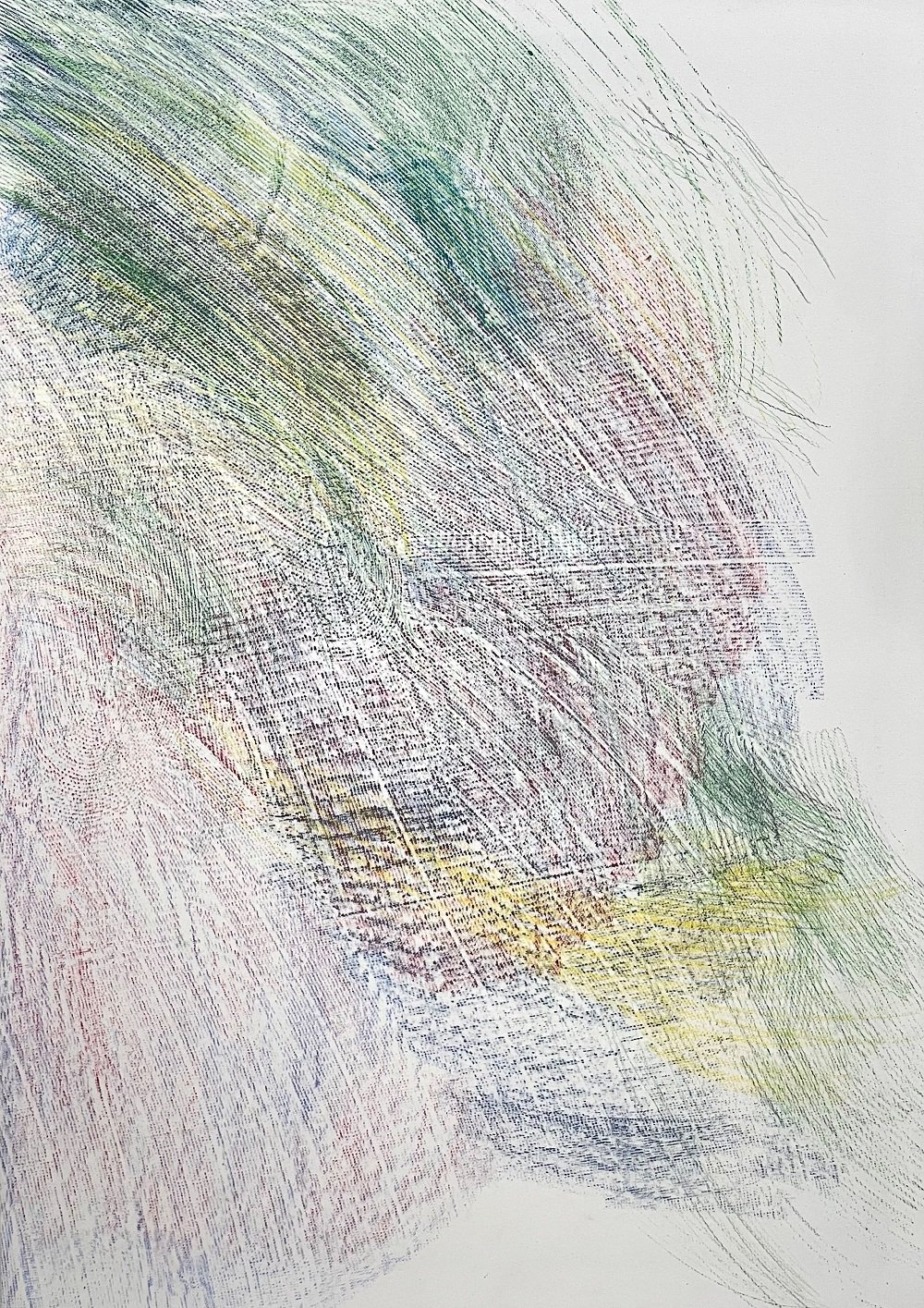
4 June - 20 August 2023
In his paintings and spatial works the artist Paul Verheul (1990, Chatham UK/NL) deals with the expressive meaning of gestures and materials. An important starting-point is the dialogue between material and gravity. In addition he makes use of the natural qualities of materials – the flowing of paint, the creasing of fabrics or the flexibility of wire. The expressive force in his work is usually the result of movement, rhythms and unexpected contrasts.
This is what the jury of the SBK Otto Hetterscheid Stimuleringsprijs said about his work:

“In his spatial installations and paintings this artist evokes a poetically weightless world, by means of motion, gesture, rhythm and repetition. Using earthly techniques of textile, sewing, drawing and etching he manages, in a subtle and abstract way, to make a connection with the elusiveness of light, air and space.
The spectator is personally lifted a little, gravity drops away for a moment. This is an intriguing experience. We look upon this artist’s versatility and passion as an important source for his further development.”

In 2013 Paul Verheul took his BA (Hons) Fine Art: Painting at the Camberwell College of Arts, University of the Arts London. In 2022 he obtained his MA Fine Arts and Design: Painting (Cum Laude) at the Minerva Art Academy/Frank Mohr Institute, Hanzehogeschool Groningen. In 2022 Verheul was nominated for the Buning Brongers prize and the George Verberg Stipendium. He won the SBK – Otto Hetterscheid Stimulation prize during the yearly SBK Sprouts Young Talents exposition in 2022.
Paul Verheul lives and works in Groningen.

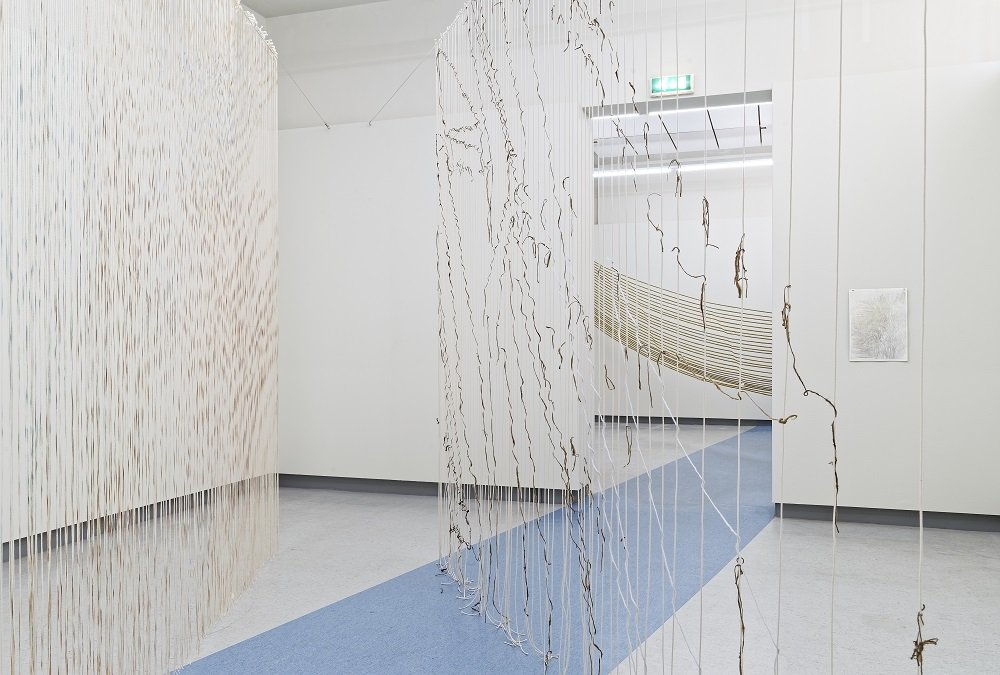

March 5 to May 21, 2023
As a Frisian artist, Alle Jong (1988, Hemrik) is very concerned with our deeper history and visual language: from dolmens, mound life and Frisian Runes to even further back in time. Alle Jong builds bridges between the present and the past with his visual work in a very special way. His young but versatile oeuvre is full of references to the time before Modernism made its appearance. The media he uses vary from giant charcoal drawings, original 17th, 18th and 19th century archives, decades-old, unopened letters to video games and 3D animations.
A series of new drawings can be seen in the solo exhibition 'Oer'. In his drawings trees loom in black holes, which he imagines as shafts of light, peering out from our brain. The ritual emptiness of a hunebed boulder, or our own brain in which trees also grow. This poetic view shows a deep-rooted awareness that art has been with us for a very long time.
Alle Jong sometimes wonders whether we carry 'primal thoughts', archetypes that evoke a memory or a feeling that are hundreds of thousands of years old.
How stilled is such a realization, as if you make contact with a shadow in the dark from an incomprehensible distant past. In the exhibition, this stillness has been translated to perhaps a few flowing primal thoughts.


Alle Jong studied at the Academy Minerva in Groningen and was nominated for various prizes during his graduation. He received two grants from the Mondriaan Fund. His work has been shown in various Dutch museums. His work is included in the book 'FRYSK, 100 years of painting in Friesland', Museum Belvédère (2018).
PAST EXHIBITIONS 2022

December 4, 2022 to February 19, 2023
Kamilė Česnavičiūtė (1996), born in Lithuania, came to the Netherlands in 2015, studied at Academy Minerva and lives and works in Groningen. Kamilė paints graphic images saturated in color with drawn elements, visually uncomplicated, but always driven by the story
behind it. The solo exhibition Convention has a three-piece structure and shows a series of new paintings and drawings. Kamilė's work is in many ways a search for another reality. Inspiration can come from surrounding society and the flow of global events. Interests and motivations range from everyday things, experiences, reality checks and escapism.
'Sometimes I find myself thinking of how to escape this reality or find actual meaning in a world so cruel and filled with nonsense. The title Convention came up from a drawing I made where very different figures are standing together as if they came to figure something out.'
Kamilė sees the exhibition as a place to share this burden. Starting with brightly colored paintings like glimpses of our flawed world.
At the center of the exhibition are drawings with black and white lined figures coming together and having a convention to discuss the situation that the world is almost on fire. In the last section, larger paintings can be seen that reflect her backward mood.
By reducing humans to a silhouette in her paintings, they function as each of us, imprisoned in their role and place. Her use of bright, sometimes gooey colors add to the atmosphere or contrast with the
mood of the work. The individual emotions, often subtly drawn, give the figures a tragicomic, funny and sometimes uncomfortable character. Stories that reflect the relationships between people, question our behaviour, generalize and make it seem absurd in a painted life.
Kamilė Česnavičiūtė was educated at the J. Vienozinskio Classical Art Academy in Vilnius (Lithuania) and Academy Minerva.
She won the Sluijters Prize and was nominated for the Buning Brongers Prize. In 2021 she received an Artist Start grant from the Mondriaan Fund.


September 4 to November 20, 2022
Aafke Ytsma (1988, Voorburg NL) was raised in The Hague and Friesland and currently lives and works both in Leipzig and Leeuwarden. In 2019 she won (a shared) Young Art Noord (professional jury) in Museum Belvédère. A solo presentation in Afslag BLV was linked to this prize.
The exhibition Moments in between shows new paintings and woodcuts in the Japanese technique. The collection of works gives the impression of an overarching but veiled plot. While in the individual works the story seems to branch out rather than condense. In the seemingly everyday performances, characters walk in and out. Someone is on the way in the car, a market gardener is harvesting vegetables in the field, a cat is running down the street at night, the door is ajar in an empty hall. The insignificant and casual moments possess a stillness that at the same time makes one wonder what came before or what is yet to happen. In their contexts, they explore contemporary times and the way in which we move and relate to the world.
“I'm interested in the moments you overlook, when your gaze or thoughts wander unnoticed, the in-between moments that divide time or connect two events.”

Aafke Ytsma often works in series in which she sheds light on the same subject from different angles. The constructed reality in her paintings is a collage of impressions. Characters and locations are taken from her daily life, supplemented with image fragments from films, art history or photos from magazines or the internet.
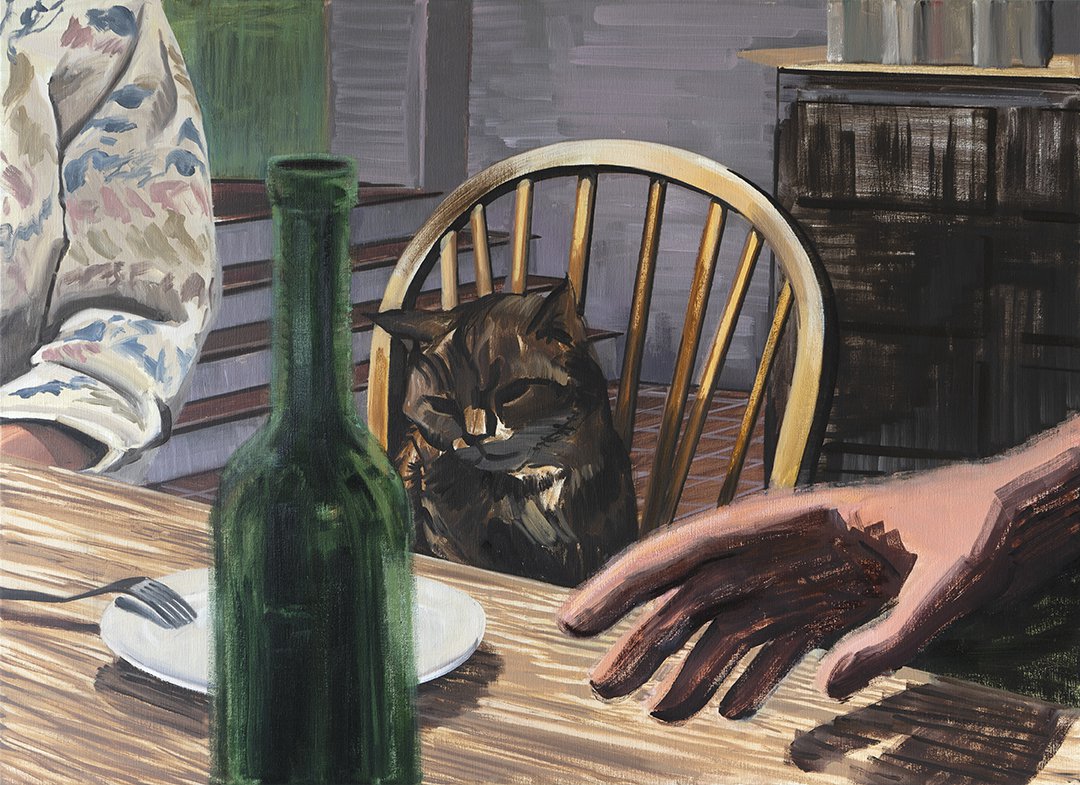
Aafke Ytsma studied art at (CaBK) ArtEZ, Zwolle. She has exhibited in a.o. melklokaal, Museum Arnhem, Municipal gallery Pafos (CY) and THALER Originalgrafik (DE). Her work was nominated for the Royal Prize for Free Painting and is included in the collection of the Fries Museum, the UMCG and various private collections.
June 5 to August 14, 2022
Three young artists, partly educated and living in Groningen, took the concept of equidistance as the starting point for this exhibition. In mathematics, ‘a point is said to be equidistant from a set of objects if the distances between that point and each object in the set are equal.’
“The term equidistance in our research was born out of the feeling of belongingness. As a trio, in which each one of us shares a different background, we aim to share our different frequencies for this given period we are in. We would reclaim these collected moments through diverse mediums and express them in the exhibition. Three different artistic languages blow up and come together in a collaborative work united by the concept of equidistance – a point of equal distance.”
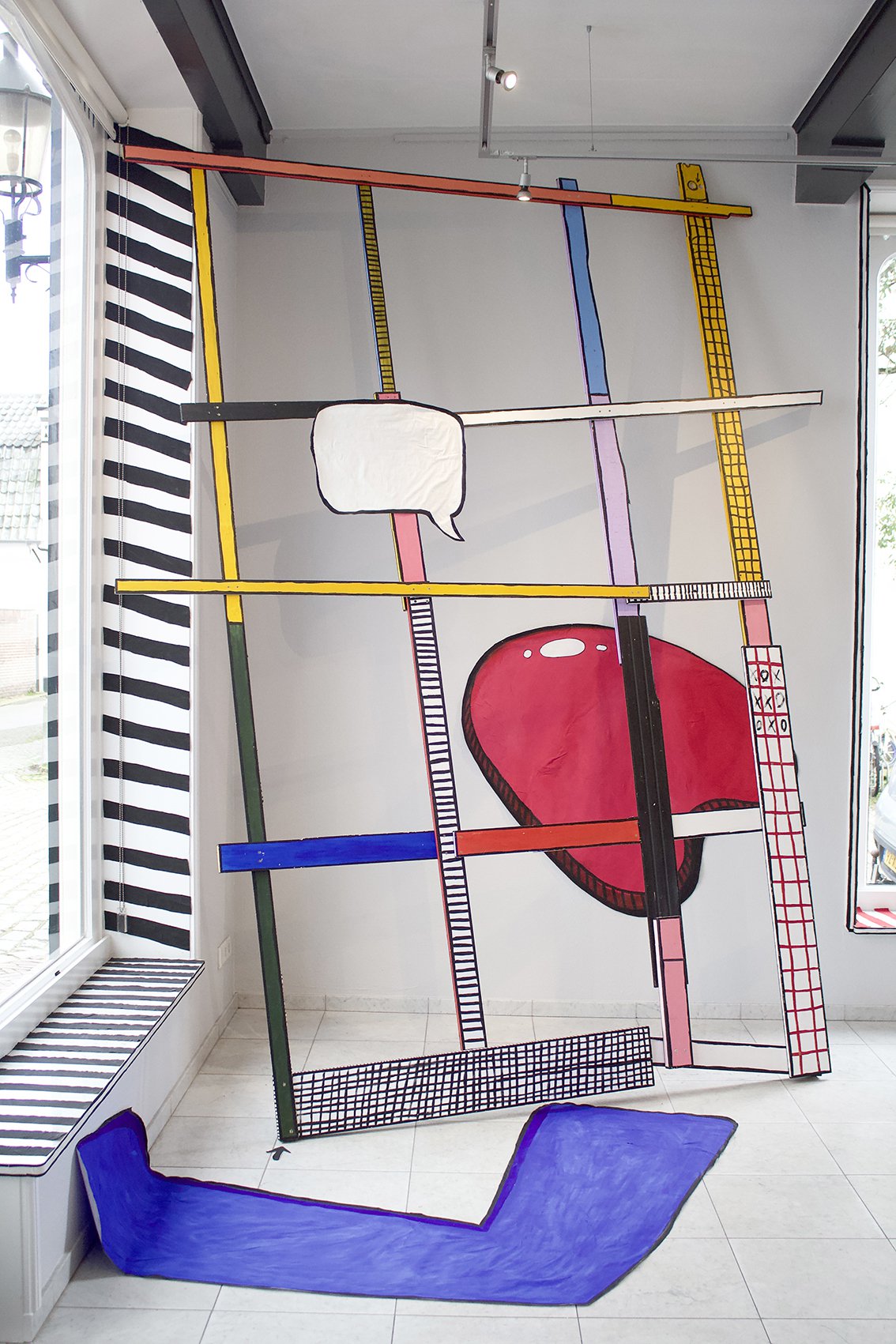
Karina Puuffin
Karina Puuffin (1997, Ukraine) moved to The Netherlands when the situation in Eastern Ukraine got unstable and unsafe. Puuffin’s art is a celebration of art. Inspired by Modernism, she is trying to break through the traditional ideas of the medium, merging paintings into sculptural objects and vice versa. With her work Good painting in this show she throws a question: What makes a work of art worthy to show in the museum? Good = value, but value ≠ good.
In the contemporary art world the value of the artwork is no longer determined by its quality. White cube walls are considered to be a supreme presentation space and “a good painting” has become an abstract term to identify a piece that is successful, appreciated and highly regarded. In Karina Puuffin’s satirical installation the merging between wanted and unwanted, authenticity and fakery, cheap and expensive takes place. Her project is both a statement and an experiment to see whether or not the perception of an art viewer is easily manipulated. From something cheap, forgotten, unimportant and cliche to something “valuable”.

Ottokaji Iroke
Ottokaj Iroke (1989, South Korea) is a multi-disciplinary artist based in the Netherlands, originally from Seoul. He studied painting for his Master's at Frank Mohr Institute. Ottokaji is fascinated by the power topology of economy, sports and hip-hop. His daily life and interests are combined, and he aestheticises them daily. His life is a suggestional transformation of his arts and mentality. He turns political issues into perceptual experiences.
Ottokaji presents his work ‘That's all football’ for this show, an installation with a performance video and sculptural paintings. He made 20 pieces of sculptural paintings from children's football nets.
Ottokaji visited Abe Lenstra Stadion of SC Heerenveen for the video work to record site-specific sound. That day when he was there, the 15th of May, SC Heerenveen won against Go Ahead Eagles by 3:1. It was the last match of the season for them. His performance video shows how he is playing in his studio. He presents all of these for this show. The audiences are welcome to play with his settings too. Everybody is welcome to his stadium.
Celina Bermudez Vogensen
Celina Bermudez Vogensen (1996, Portugal) is Nicaraguan, Portuguese, and American and works with topics exploring the intersection between nature, migration, territory and identity in which their personal experience is the main source of their works. Celina explores these topics through various media and approaches.
Celina will be exhibiting ‘myths and metamorphosis’. “They are fascinated by the concept of overcoming the tradition of silence and building new stories and images that indicate relationships among themselves and between species. They want to explore commonly known myths and symbols for this exhibition along with more unknown ones. In narratives, stories and imagery that denote interspecies relations. Fables, myths and footage of animals and plants communicating.”
Human and animal metamorphosis presented in the form of video, prints, paintings and miniature sculptures.


AFSLAG BLV, annex of Museum Belvédère in the Heerenveense School in the center of Heerenveen, has started again with the new exhibition program and a new programmer: Albert Oost, artist, initiator of melklokaal in Heerenveen and also works as a collection manager at Museum Belvédère, after a minor renovation.
To start with:
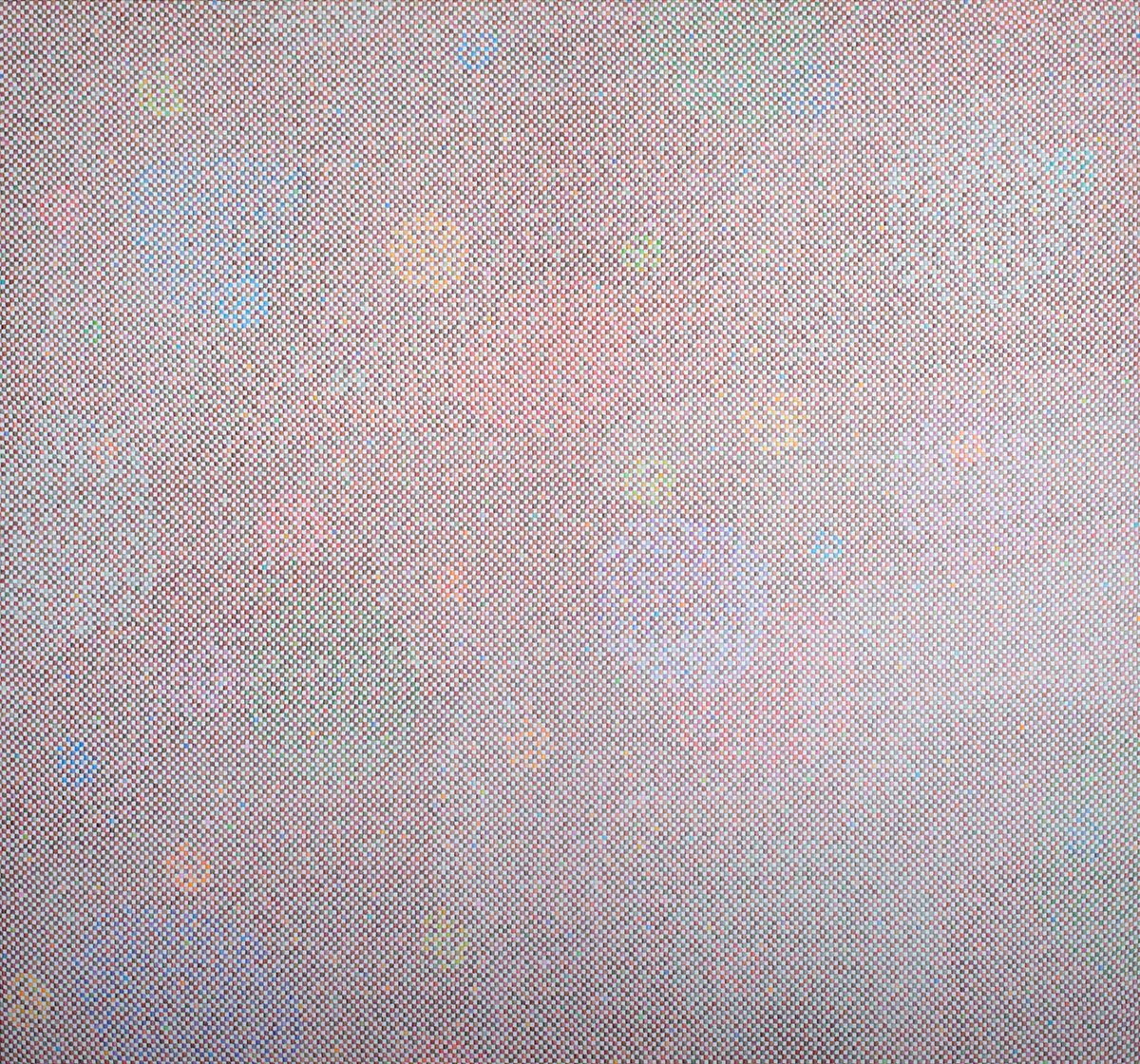
March 6 to May 22, 2022
The canvases of Henrik Kröner (1979, Nordhorn, DE) living in Groningen look like thin colored pencil drawings on thin on unprepared, squared canvas, which evoke associations with the paper of a simple arithmetic notebook. The sense of touch is exchanged for the sense of looking, touching with the eyes, the gaze.
This exhibition revolves around a dance, the square dance. The mathematical rhythm of all small squares. It is not a static dance but it goes back and forth, crisscrossing each other. The works shown come from various series of Henrik Kröner's oeuvre.
Where previously the emphasis was mainly on color and light progression, color spots and round shapes can now also be recognized. Simple compositions with a decorative look. The textile and tactile character of the work is omnipresent.
Kröner comes from a textile family. His grandmother studied textile design in Hamburg in the 1930s and his father is a textile engineer. The checked fabric in this exhibition comes from the factory where his father still works.
As a young student he started in math class with drawing the squares in his exercise book. “As an artist, I cherish boredom as a source of inspiration. Things can arise out of boredom.”
In recent years, Kröner has immersed himself in the two old stories Noli me tangere and Pygmalion. What interests him in both stories is the tension between the prohibition and the desire to touch something. Touching with the eyes and with the touch, our skin.
Pygmalion is also about the myth of the artist, the creator. Kröner is critical of this romantic idea. He asks himself questions such as: what is authentic, how do we judge something as good art and how is it appreciated.
You can read a review of the exhibition here:
Leeuwarder Courant (March 18, 2022)